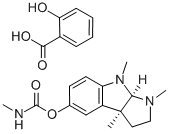Chemical Properties
solid
Uses
Physostigmine salicylate (Eserine salicylate) is used as bulk pharmaceuticals (parasympathomimetic, cholinergic, ophthalmic, anti-Alzheimer). Product Data Sheet
Uses
cholinergic, anticholinesterase, miotic
Definition
ChEBI: Physostigmine salicylate is an azaheterocycle salicylate salt and a member of salicylates. It contains a physostigmine.
brand name
Antilirium (Forest); Isopto Eserine (Alcon).
General Description
The salicylate ofphysostigmine (eserine salicylate) may be prepared byneutralizing an ethereal solution of the alkaloid with anethereal solution of salicylic acid. Excess salicylic acid isremoved from the precipitated product by washing itwith ether. The salicylate is less deliquescent than thesulfate.
Physostigmine salicylate occurs as a white, shining,odorless crystal or white powder that is soluble in water(1:75), alcohol (1:16), or chloroform (1:6) but much lesssoluble in ether (1:250). On prolonged exposure to air andlight, the crystals turn red. The red may be removed bywashing the crystals with alcohol, although this causes lossof the compound as well. Aqueous solutions are neutral orslightly acidic and take on a red coloration after a period.The coloration may be taken as an index of the loss of activityof physostigmine solutions.
General Description
Crystal form that turns red on exposure to heat or light.
Reactivity Profile
Behaves as a weak acid in solution.
Health Hazard
PHYSOSTIGMINE SALICYLATE is similar to physostigmine. It is classified as super toxic. The probable oral lethal dose (humans) is less than 5 mg/kg or a taste for a 150 lb. person. It is a cholinesterase inhibitor.
Fire Hazard
When heated to decomposition, PHYSOSTIGMINE SALICYLATE emits toxic fumes of nitrogen oxides.
Biological Activity
Acetylcholinesterase inhibitor th at crosses the blood-brain barrier and forms a carbamylated enzyme complex with acetyl cholinesterase th at degrades slowly.
Safety Profile
Poison by ingestion,
subcutaneous, intramuscular, intravenous,
and intraperitoneal routes. Human systemic
effects: arrhythmias, nausea or vomiting.
Experimental reproductive effects. When
heated to decomposition it emits toxic
fumes of NOx See also
PHYSOSTIGMINE.


